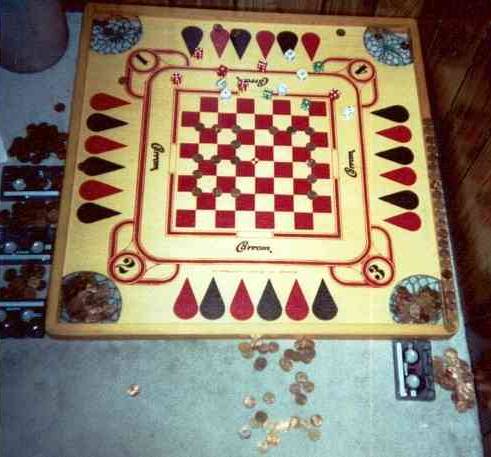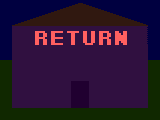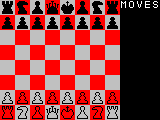
How do you play Hit-a-bump?
1. Introduction
Because Hit-a-bump has many versions of play, I cannot directly give the rules for the game. To get the rules, get them from the version you wish to check out. If you're checking out the latest version, version 6, there's a special board you need to have in order to play this. Clicking that link will take you to another list. This'll give the the instructions on how to construct the board [in either US measurements or metric measurements [includes a special printable version with instructions on how to avoid printing in color [and/or without the ads]]], and the main rules of the game on that same page.
2. The versions
Learn about a version of hit-a-bump and it's specific rules in the links below:
Hit-a-bump home
Hit-a-bump version 1
Hit-a-bump version 2
Hit-a-bump version 3
Hit-a-bump version 4
Hit-a-bump version 6
Hit-a-bump version 6 board construction
3. History of development
The very beginning
Hit-a-bump's origin was outdoors when waiting for something. A long time ago, I was interested in playing baseball [and still sort of today]. While I was waiting for everyone to arrive, which could take up to 30 minutes, I had to find a way to keep myself busy. This was the time in which I didn't have my mind game available to play*. There were plenty of rocks lyin' around in the area, so I decided to use those. Hit-a-bump was the very first game I made that didn't require another board game company's items, it simply used items that come free with the planet: rocks. Just throwing the rocks a short distance wasn't good enough and wasn't all that much fun. To make it better, the rocks had to collide. The name of the game came from this. The rocks looked like bumps, and you're supposed to hit them. Hit-a-bump is the name of the game, get the name and origin?
Because my supply of rocks was limited, and since throwing them out there would reduce this stock, I won't be able to refill my stock unless some change was done. Indeed, a little while later, I thought of removing the rock that was hit. Though this'll never clear the board and that you're likely to run out, to solve that, the rock that you threw in addition to the rock that was hit are removed at once. This includes all other rocks hit as well. Extras offered bonuses.
Versions 2, 3, and 4
Version 2 came because I never really liked it outdoors as I can't do much of the stuff I really enjoy [except swimming], I thought of a way to play it indoors. Because I had tons of flash cards [multiplication and division ones], this is when version 2 was born. Because, if hitting the cards while on the ground while the card was still moving, it was extremely difficult to judge whether the card was hit or not by the throw. This caused me to make the confirmation with overlapping giving the birth of the overlapping concept in hit-a-bump.
Version 2 was dull without score, so I made version 3 have the score, which is why it's so identical to version 2. Knowing that more overlapping was worth more points, I developed the system of scoring as you'll see in it's section. The original scoring method was much like that of version 5. I've editted it for your convenience. If you'd like to play by the true version, you'll need a distance-measuring source. Every foot out [or 30.5 cm] from 3 feet from you means that you multiply the score you got by this number. To find this number, take the distance it is from you, and subtract 3 and round to the nearest foot [30 cm]. If the hit-a-bump's center was 7.3 feet from you'd you'd subtract 3 to make 4.3 and round to 4. Multiply your score you got by this number.
Version 4 came a long time later. While playing with my marbles and the game Marble-pool, I thought it was very likely to make the game hit-a-bump with this. After playing around trying to set the best criteria, I finally came up with Version 4 of hit-a-bump about 5 months later.
The ultimate version
Version 5 was a cross between a gift and an invention. It could not have been possible if my parents did not give me this board they had [shown in the image above]. By then, I already had over a thousand pennies, but that wasn't much to worry about. Now, I have in excess of 16000 pennies [as of May 1, 2004 and plan to gain a 1000 a month for quite some time. Version 5 applied the same distance-score rule as version 3, however, it was accurate to the quarter of an inch. On the other side of the board used is a bunch of black dots. Though I don't remember the formula, I think it was something to do with taking the distance and squaring it, but it was a multiplied number of the distance [I think it's 5 or 8, where every 5 or 8 dots would be one main mark, I didn't mark it on the other side of the board so I didn't know as back then, I never thought of having a site. This was in 2000, My site started in August of 2001.] and the rules for version 3 for the scoring method also applied. Version 5 had no multipliers of any kind, not even the dice, but the launching method and foul boundaries [and concepts] were left the same for version 6.
Version 6 is the ultimate near-commercial quality version of the game. There are still some edits being made to it, but are getting fewer by the month. Version 6 was born from massive fixes and simplifications to version 5. In fact, I was making the biggest of edits and fixes for nearly 3 full weeks! After that, the true version came about. There were still edits to the scoring concept, mainly to make it simpler and more readily done. Beyond scoring, I then thought of multipliers, as with pinball games, to further boost the score. Getting past 99,999,999 points would literally take about 2 years on an average run now, but then, it would've been as long as 30 years to reach that same amount! Yet, not only did the multipliers solve this issue, they made the game far better and more tournament-worthy! By far, Version 6 is a thousand times better than all previous versions put together and it's the best of all my games I've developed [in my opinion]!
The future
As for the future of hit-a-bump, there's basically no changes that I can see yet as far as new versions and updates, however, once I get to know computer programming enough to make games, that would be one of the top things on the list of "programs to make". As I see it, it might be around the year 2005 or 2006 before this actually happens, so don't be too eager as that's more than 6 years away yet!
Footnotes:
* My mind game's general concepts on how it runs and plays are explained very well here.






